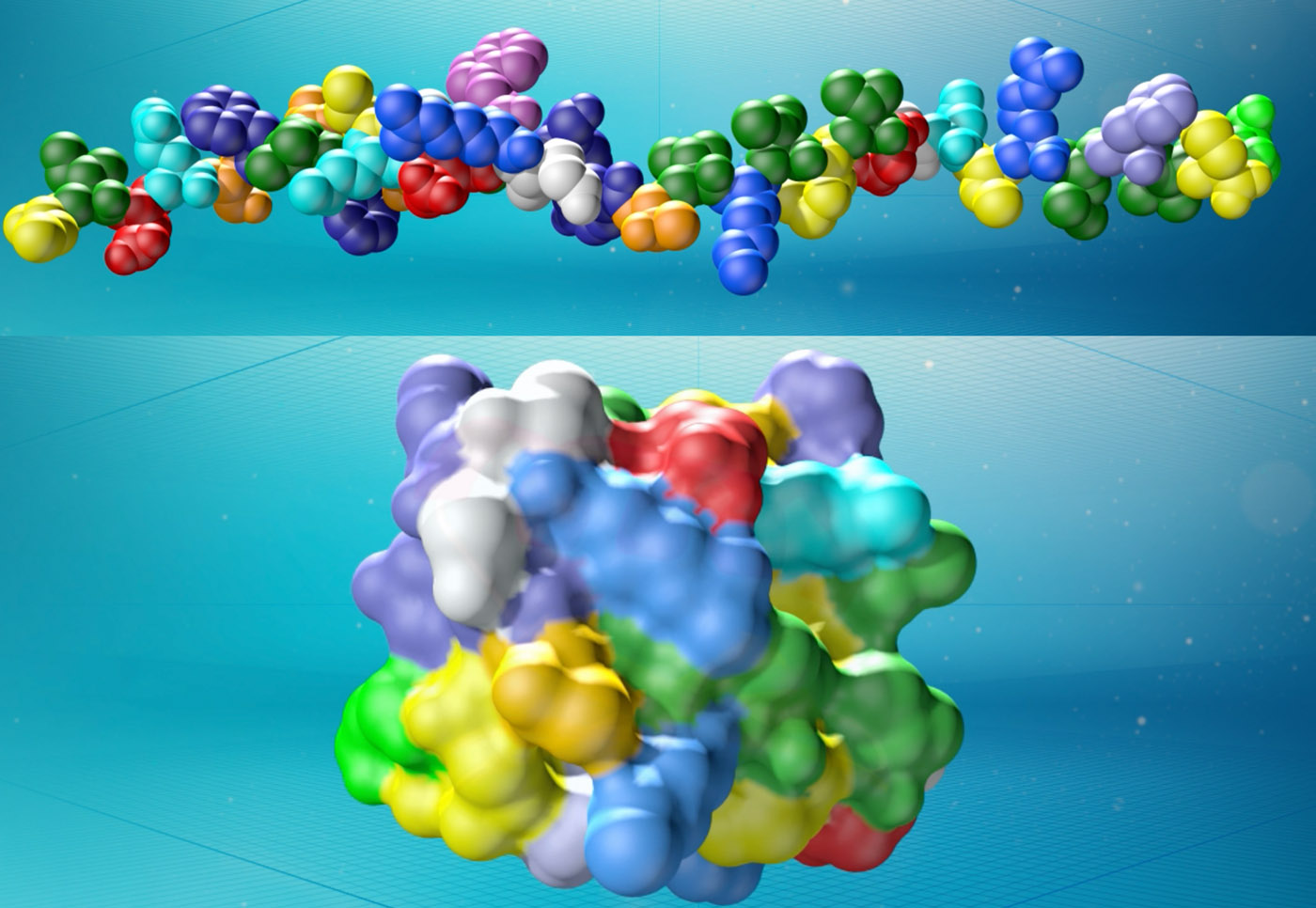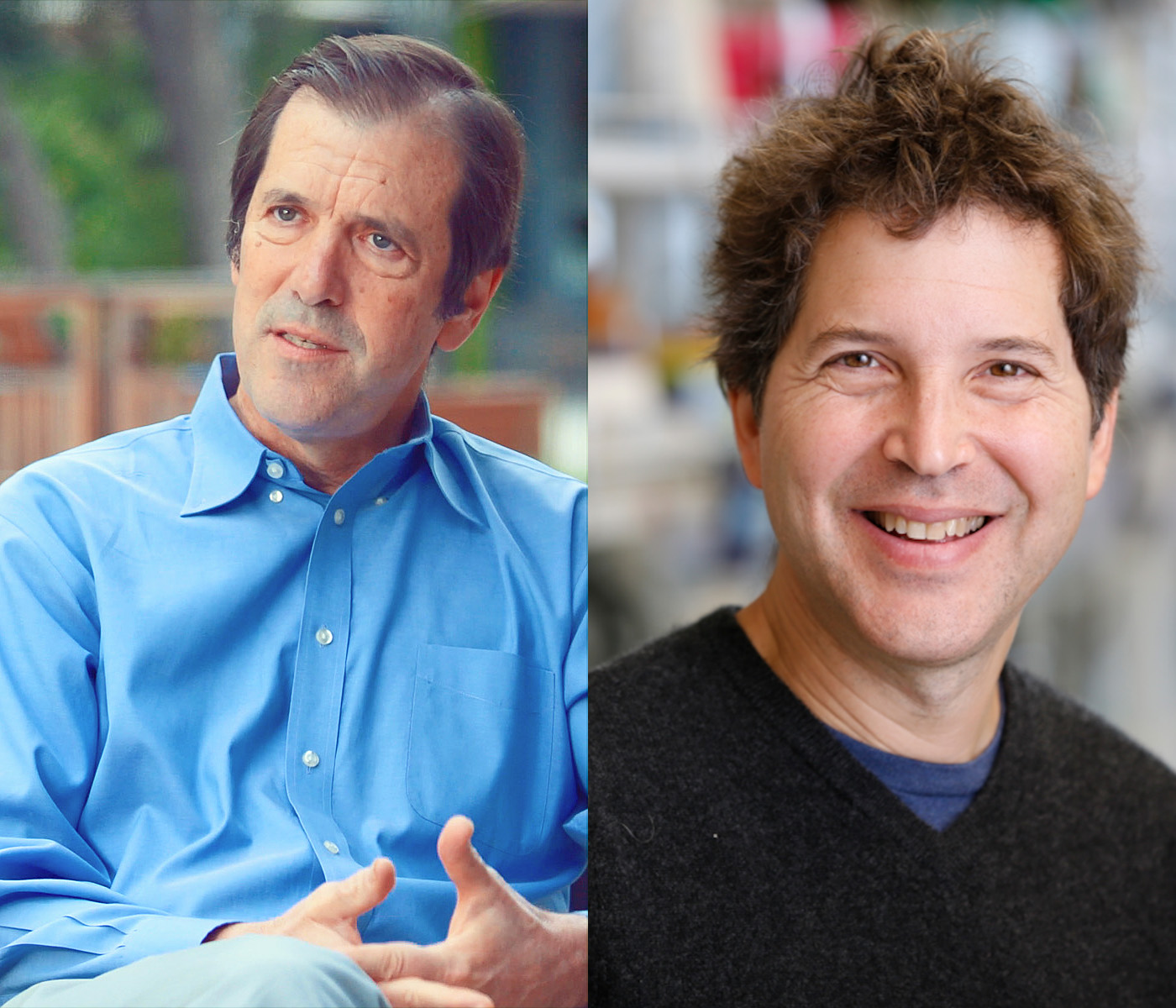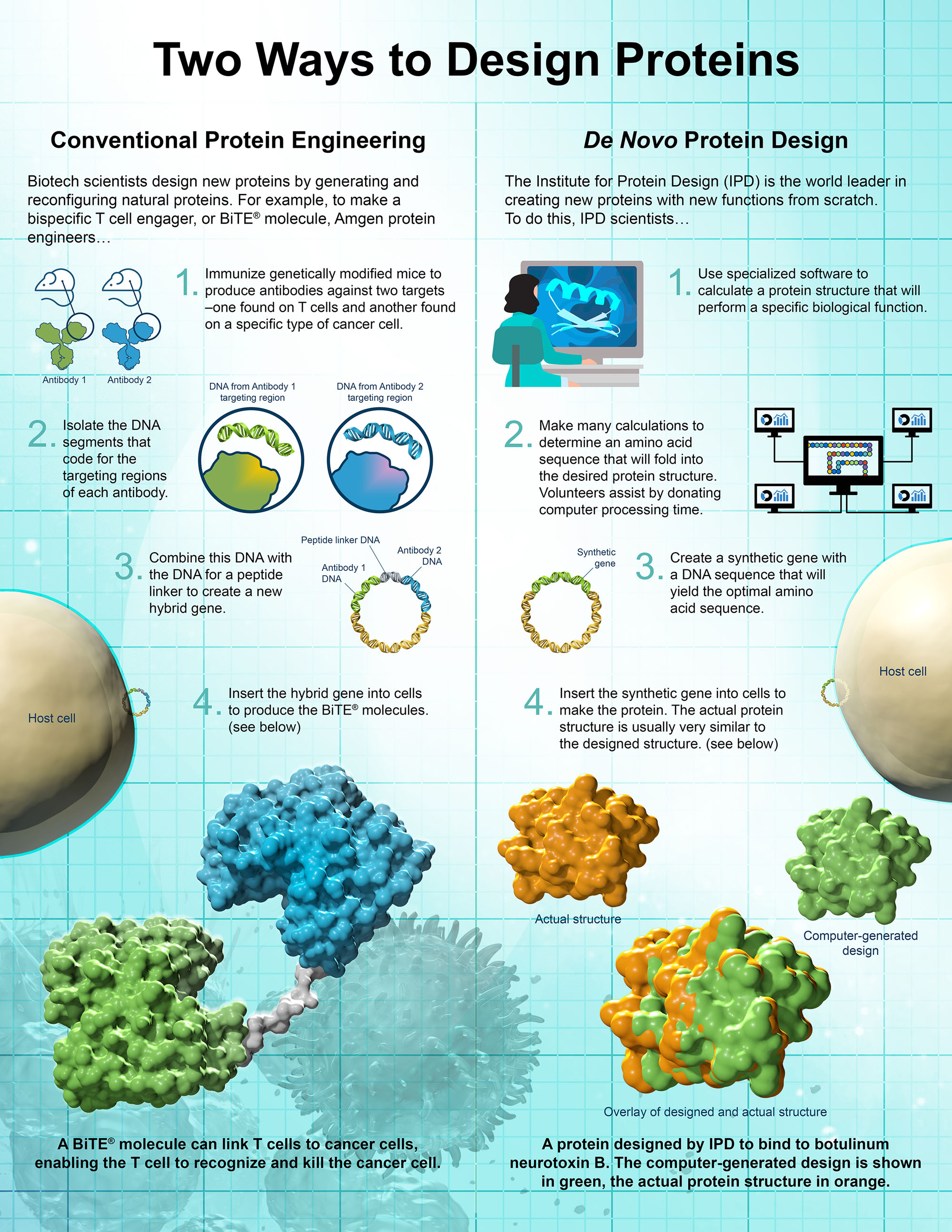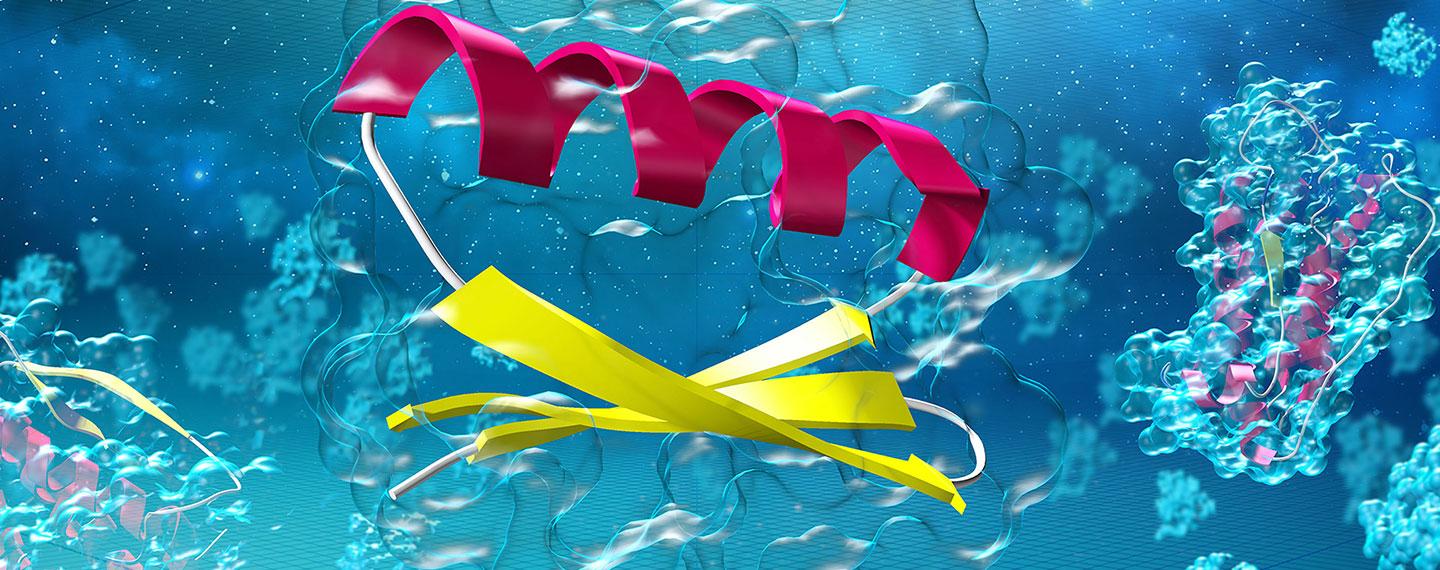When biology wants to get something done, it almost always assigns the job to a protein. Increasingly, medical science is also turning to protein-based therapies, which have grown more sophisticated as scientists find new ways to rearrange nature’s building blocks. However, if David Baker is correct in his predictions, the prevailing state-of-the-art approach in protein drug design could be seen as out-of-date in a little more than a decade.
Baker is a Professor of Biochemistry at the University of Washington and a Howard Hughes Medical Institute investigator. He also founded and directs the university’s Institute for Protein Design (IPD), which is doing something once considered impossible—creating proteins from scratch. To put it in more familiar terms, biotech scientists work with nature’s LEGO®, but Baker and IPD have learned how to make their own LEGO® pieces.
“David doesn’t start with a natural protein at all—he invents a protein,” said Ray Deshaies, senior VP for Research at Amgen. “He decides what three-dimensional structure he wants, and he uses sophisticated software he designed to predict an amino acid sequence that will fold up to yield the desired target structure. And more often than not, it works.”
“In 10 to 15 years,” Baker predicts, “I believe that nearly all the proteins used in technology will be designed de novo to have the properties that are wanted, rather than properties adapted from something that happened accidentally during evolution.” The emerging science has already led to investigational proteins designed to be biosensors, cancer immunotherapies, and a universal flu vaccine.
Audacious but accurate
The boldness of IPD’s vison and its remarkable progress to date has attracted media interest as well as financial support. In April 2019, the institute received a five-year, $45 million investment from The Audacious Project housed at TED. The grant aims to hasten the day when de novo protein design will yield significant new products, including medicines.
On that goal, Baker and IPD have found common ground with Amgen in the form of a unique research collaboration. “We want to work with IPD in an open-ended way to try to solve some of the most intractable problems that we face in designing effective medicines,” said Deshaies. “This is a broad collaboration that will cover multiple projects, and we’re hoping to build strong working relationships among scientists on both sides. The goal isn’t just to solve a few specific problems but to create approaches that can be applied very generally across a large suite of problems.”
Baker said that the more wide-ranging research relationship with Amgen could have advantages over narrow collaborations built around single projects. “Each project we do with Amgen will be testing out a new technology. It might turn out that for one particular project, the technology isn’t the best fit, but there could be other projects where it’s a perfect fit. We’re taking a more global view, and I think that will allow us to identify connections which might otherwise be missed.”
To appreciate the audacity of IPD’s research agenda, you need a basic grasp of what’s known as the protein folding problem. All proteins start out as chains of amino acids strung together, and the way these chains fold up into 3D structures determine a protein’s shape and function (see graphic below). The problem is that when you calculate all the variables involved in the folding process—the length and sequence of amino acids, the angles of the bonds they form, etc.—there’s an astronomical number of possible ways a protein could fold. The number of potential folds in a typical human protein far exceeds the number of atoms in the universe.

Our bodies make proteins by translating the DNA letters in our genes into chains of amino acids (top image). These amino acid chains fold into three-dimensional proteins (bottom image). Calculating how they will fold and what shape a protein will take based on its amino acid sequence is extraordinary difficult.
In nature, of course, a protein has one preferred shape, and it finds that shape very quickly. Just as water flows downhill until it finds the lowest point, proteins tend to fold into their lowest energy conformation. But predicting that lowest energy state from a protein’s amino acid sequence still requires deep insights and prodigious computing power.
“You would think it would be almost impossible to design a new sequence that folds up to a new structure because the size of the structure space is so enormous,” Baker observed. “One of the major points coming out of our work was that the problem is actually nowhere near as hard as you would have thought it to be.”
For starters, Baker’s team has learned that in protein design, perfection isn’t required. “If you build proteins based on what you understand, you can actually get much further than what you might think. If we understand 75 to 80 percent of the problem, we focus on those parts. We can put enough into our design calculation so that it’s almost certain the protein will fold up to the desired structure.”
Years of tackling increasingly difficult computational problems have helped IPD to reach a major inflection point. “We’re starting to design proteins to have specific functions,” said Baker. “That’s where our work starts tying in to medicine and to Amgen.”
Better immunogens and smarter BiTE® technology
In the near-term, the collaboration will seek to apply de novo design to expand the versatility of traditional protein-based medicines. For example, it’s extremely hard to make antibodies that can recognize a protein target that is mostly buried inside the outer membrane of a cell.
“With these membrane proteins, the extracellular loops can be very small and difficult for the immune system to see,” said John Delaney, an executive director in Amgen’s Research organization. “We can try to make copies of these loops and inject them into mice to generate antibodies. But often, we’re not really presenting the loops in the same context that’s found in the natural protein, so the antibodies don’t work. If IPD can create a new methodology to display these loops in their native shape, we could use that to design better immunogens and make more effective antibodies against some very promising drug targets.”

Ray Deshaies (left) and David Baker. The two once worked in the same room when they were both grad students at the University of California at Berkeley.
In treating cancer, the basic challenge has been the same for decades: How do you design drugs that hit cancer cells hard without collateral damage to healthy cells? That’s particularly important with highly potent therapies like BiTE® (bispecific T cell engagers) molecules, which tether T cells to cancer cells, enabling the former to recognize and kill the latter.
“We are trying to come up with ways to optimize our repertoire of BiTE® molecules and expand the type of problems we can solve with these molecules,” said Deshaies. “IPD could help us to find a new way to ensure that a BiTE® molecule is only active when it’s in the vicinity of a cancer cell.”
That might be possible, for example, by designing drug molecules that only become active in the presence of two distinct targets on the same cancer cell. “We could identify target combinations that are present in tumors but are very unlikely to exist together on normal cells,” said Delaney. “That could expand the range of tumors we can target with BiTE® molecules and increase their therapeutic index.”
From cool science to real medicines
The Amgen-IPD research collaboration also represents a scientific reunion between Baker and Deshaies. The two worked in the same room for several years when they were both grad students at the University of California at Berkeley. “Ray and I diverged for a while, and it’s really fantastic to be able to work together again,” said Baker.
“It would have been harder to establish this nontraditional collaboration without that long-standing personal relationship, because crafting this arrangement required taking some risk based on trust,” said Deshaies. “It’s easier to work with and trust someone if you know them and have a lot of confidence in their values and integrity.”
For Amgen, the collaboration could help it maintain its status as a leader in biotech protein engineering. The company has pioneered new structural classes of medicines by reconfiguring natural proteins to boost their disease-fighting attributes. With de novo protein design on the cusp of taking engineering to a new level, Amgen wants to climb the learning curve quickly. “We’re hoping that IPD can teach us how to approach problems in a general way, so that we can then use our own engineering savvy to translate those insights into new drug molecules,” said Deshaies.
For the institute, Baker said that working with Amgen could help to accelerate the institute’s goal of having a positive impact on society. “We want to go from really cool advances in basic science to getting real medicines out to people in the world.”





